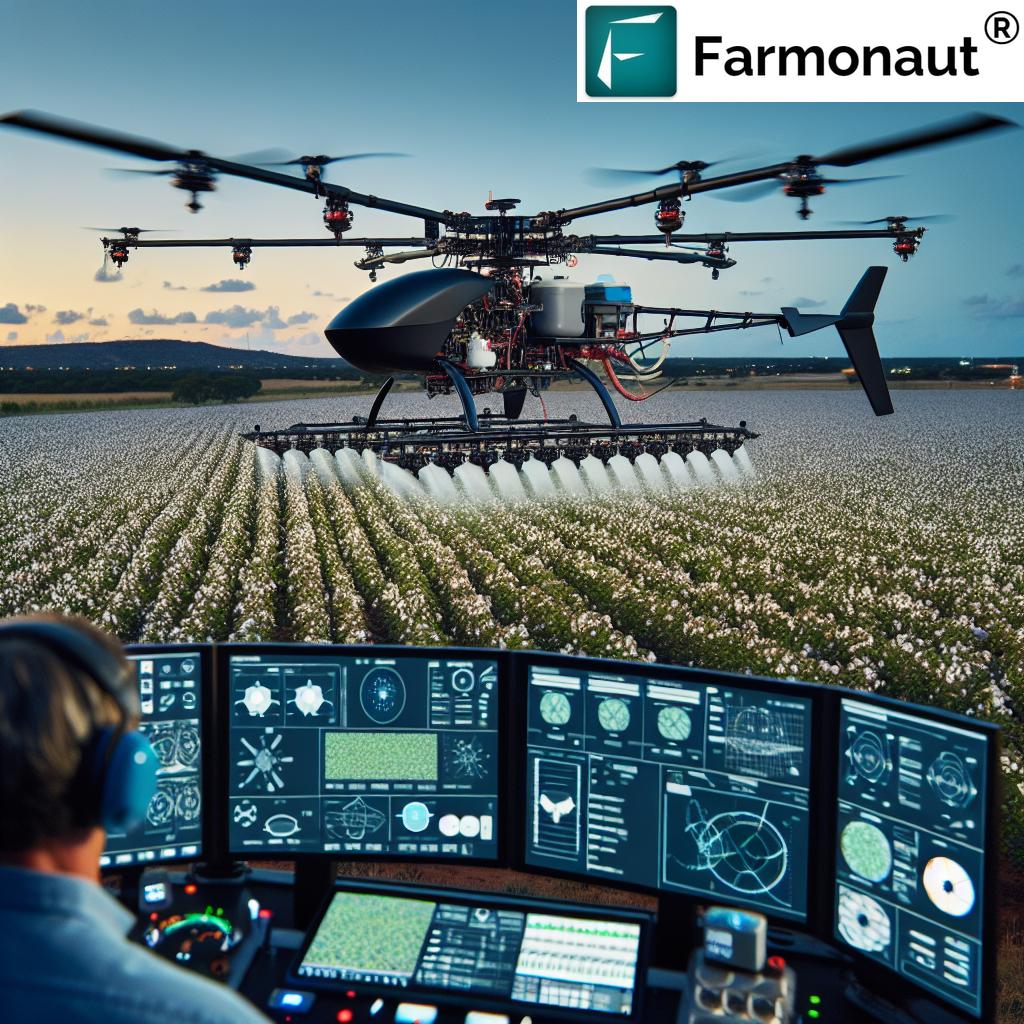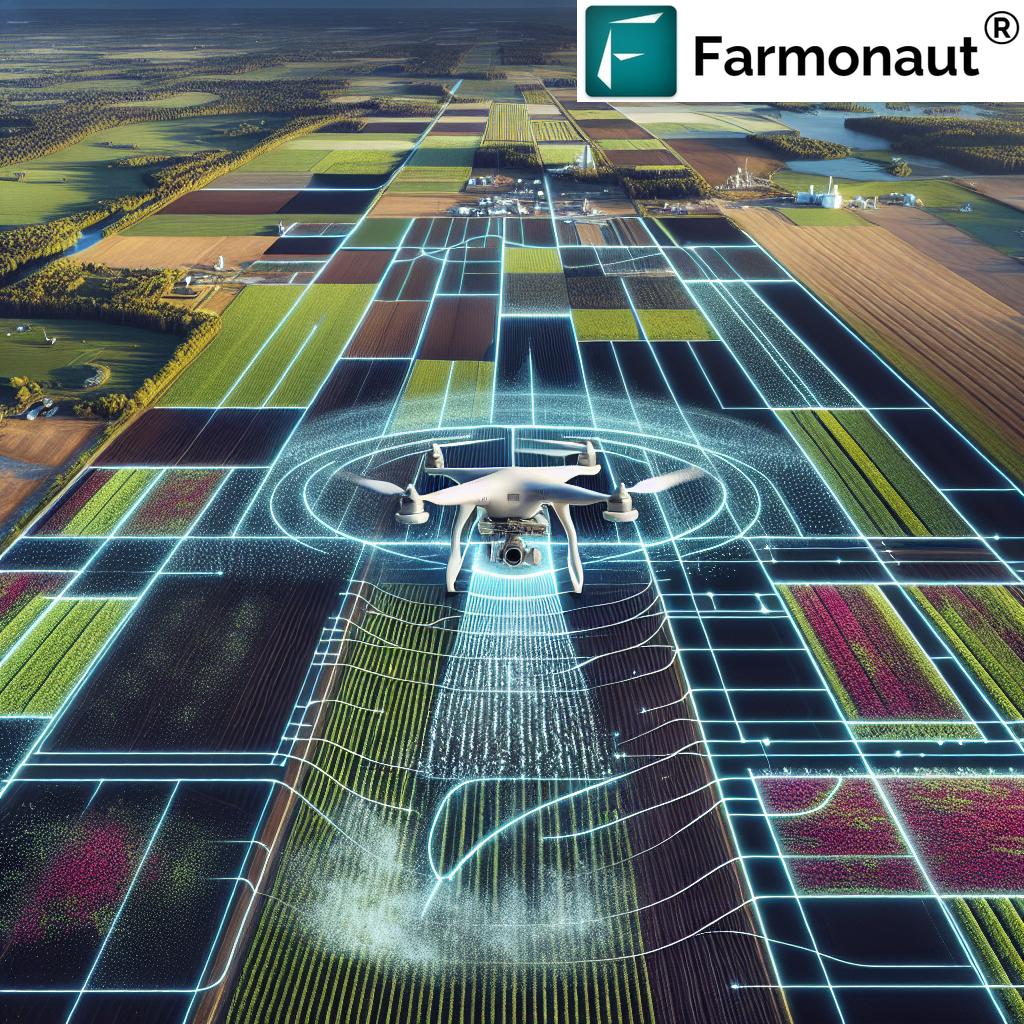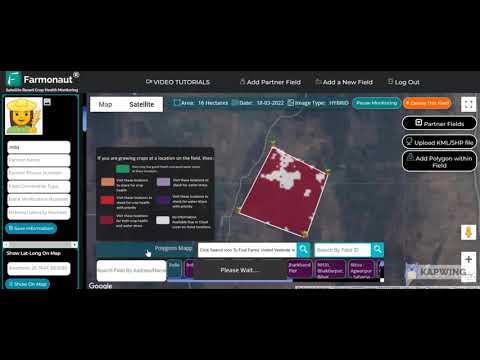Revolutionizing Texas Agriculture: How Unmanned Helicopters Are Transforming Crop Protection and Safety
In the vast expanses of Texas farmland, a technological revolution is taking flight. Unmanned agricultural helicopters are soaring above the fields, ushering in a new era of crop protection and safety. As experts in remote sensing and GIS technology, we at Farmonaut are excited to explore this groundbreaking development and its potential to reshape the agricultural landscape.

“Unmanned agricultural helicopters can cover up to 40 acres per hour, significantly outpacing traditional crop dusting methods.“
The Rise of Unmanned Agricultural Helicopters
The agricultural aviation industry has long been a crucial component of modern farming, particularly in Texas, where vast acreages demand efficient crop protection methods. However, traditional crop dusting has come with its share of challenges, including safety risks and operational inefficiencies. Enter the era of unmanned agricultural helicopters and autonomous crop dusting – a game-changing innovation that’s set to revolutionize how we approach crop protection.
At the forefront of this revolution is Rotor Technologies, a company founded by Hector Xu, a former helicopter flying student turned aerospace engineer. After extensive research into unmanned aircraft systems at the Massachusetts Institute of Technology (MIT), Xu established Rotor Technologies in 2021 with a vision to address the pressing safety issues in agricultural aviation.
The Sprayhawk: A Technological Marvel
Rotor Technologies’ flagship product, the Sprayhawk, is a testament to the power of precision agriculture technology. This unmanned helicopter is a modified Robinson R44, equipped with an array of advanced technologies that elevate its capabilities far beyond traditional crop dusting aircraft:
- Advanced Sensors: Cameras, laser sensors, and a radar altimeter provide unparalleled awareness of the surrounding environment.
- GPS Integration: Precise navigation ensures accurate coverage of target areas.
- Motion Sensors: Enhanced stability and control in various weather conditions.
- Night Vision Capabilities: Improved visibility for extended operational hours.
- Terrain Reading Technology: Allows for safe navigation over diverse landscapes.
These features collectively address many of the limitations faced by traditional drones in farming, particularly when it comes to covering vast areas efficiently.
Addressing Safety Concerns in Agricultural Aviation
One of the primary drivers behind the development of unmanned agricultural helicopters is the need to enhance safety in crop protection operations. Traditional crop-dusting flights have been associated with significant risks:
- Low-altitude flying hazards
- Pilot fatigue from long hours
- Accidents due to outdated aircraft
The statistics are sobering: between 2001 and 2014, over 800 accidents and 109 fatalities were reported in agricultural aviation. By automating these operations, we can significantly reduce the human risk factor, potentially saving lives and preventing injuries.
The Market Opportunity for Unmanned Helicopters in Agriculture
Xu’s decision to focus on agricultural applications for unmanned helicopters was driven by a clear market demand. The limitations of drones, particularly in terms of payload capacity and flight endurance, have left a gap in the market that unmanned helicopters are perfectly positioned to fill.
These larger unmanned aircraft can cover vast areas more efficiently, carrying greater quantities of crop protection products and operating for longer periods. This efficiency is crucial in states like Texas, where expansive farmlands require rapid and comprehensive coverage.
Competitive Landscape and Industry Trends
While Rotor Technologies is making significant strides, they’re not alone in recognizing the potential of autonomous aircraft in agriculture. Companies like California-based Pyka are also entering the market with their own designs for crop protection. This growing trend towards automation in agricultural aviation is a clear indicator of the industry’s direction.
As the technology matures, we expect to see a proliferation of unmanned aircraft solutions tailored to various agricultural needs. This competition will likely drive further innovation, ultimately benefiting farmers with more efficient and cost-effective crop protection options.

Navigating the Regulatory Landscape
“FAA approval for unmanned aircraft in agriculture can take up to 18 months, highlighting the complex regulatory landscape.“
The introduction of unmanned aircraft into agricultural operations brings with it a complex web of regulatory considerations. The Federal Aviation Administration (FAA) plays a crucial role in overseeing the integration of these new technologies into the national airspace. For companies like Rotor Technologies, obtaining FAA approval is a critical milestone in bringing their products to market.
The approval process for unmanned aircraft is rigorous, involving thorough safety assessments, operational guidelines, and compliance with existing aviation regulations. This process can be lengthy, often taking up to 18 months, but it’s essential for ensuring the safe integration of unmanned helicopters into agricultural operations.
Key regulatory considerations include:
- Airspace classifications and restrictions
- Pilot certification requirements for unmanned aircraft
- Operational limitations and safety protocols
- Data privacy and security measures
- Environmental impact assessments
As the regulatory framework evolves to accommodate these new technologies, we can expect to see more streamlined processes for approval and integration of unmanned aircraft in agriculture.
The Role of Remote Sensing and GIS in Precision Agriculture
While unmanned helicopters represent a significant advancement in crop protection, they’re part of a broader ecosystem of precision agriculture technologies. At Farmonaut, we specialize in remote sensing and GIS solutions that complement these advancements, offering farmers powerful tools for data-driven decision-making.
Our satellite-based farm management solutions provide real-time insights into crop health, soil moisture levels, and other critical metrics. This data can be integrated with unmanned helicopter operations to optimize spray patterns, timing, and resource allocation.
Key benefits of integrating remote sensing with unmanned helicopter operations include:
- Precise targeting of problem areas in fields
- Reduction in unnecessary chemical application
- Improved crop yield through data-driven interventions
- Enhanced environmental stewardship
By leveraging these technologies together, farmers can achieve a new level of precision and efficiency in their operations.
Explore our advanced satellite-based farm management solutions:
Addressing Concerns and Ensuring Safe Operations
While the benefits of unmanned agricultural helicopters are clear, there are valid concerns regarding their integration into existing agricultural aviation practices. Industry leaders like Lukas Koch from Heinen Brothers Agra Services have highlighted potential risks, particularly when unmanned systems operate alongside manned aircraft.
To address these concerns, companies like Rotor Technologies are implementing robust safety measures:
- Advanced Communication Systems: Ensuring constant contact with ground control
- Emergency Protocols: Including controlled emergency landing capabilities
- Collision Avoidance Technology: To prevent accidents with other aircraft or obstacles
- Comprehensive Training Programs: For operators and support personnel
These safety measures are crucial for building trust in the technology and ensuring its successful adoption across the agricultural sector.
The Future of Agricultural Aviation
As we look to the future, the potential for unmanned helicopters in agriculture is immense. Xu anticipates significant production challenges as demand grows, particularly in markets like Brazil with more lenient regulatory environments for agricultural technologies.
Key developments we can expect in the coming years include:
- Increased automation and AI integration in flight operations
- Improved battery technology for extended flight times
- Enhanced data integration with farm management systems
- Development of specialized variants for different crop types and applications
The year 2025 could mark a pivotal transition towards mass production, potentially revolutionizing the agricultural aviation industry.
Comparison of Agricultural Aviation Technologies
| Features | Traditional Crop Dusting | Unmanned Helicopters | Agricultural Drones |
|---|---|---|---|
| Operational Range (acres) | 500-1000 | 300-500 | 50-100 |
| Payload Capacity (gallons) | 300-800 | 100-300 | 1-5 |
| Average Flight Time (hours) | 3-5 | 2-4 | 0.5-1 |
| Safety Rating (1-5) | 2 | 4 | 5 |
| Precision of Application (1-5) | 3 | 4 | 5 |
| Cost Efficiency (1-5) | 3 | 4 | 3 |
| Regulatory Complexity (1-5) | 3 | 4 | 2 |
Integration with Farm Management Systems
The true power of unmanned agricultural helicopters is realized when they’re integrated with comprehensive farm management systems. At Farmonaut, we provide tools that can seamlessly connect with these advanced aircraft to create a holistic approach to precision agriculture.
Our platform offers:
- Real-time Crop Health Monitoring: Identify areas needing attention before scheduling spraying operations.
- Weather Forecasting: Plan optimal spraying times based on accurate weather predictions.
- Field Mapping: Create precise application maps for unmanned helicopters to follow.
- Data Analytics: Analyze the effectiveness of spraying operations over time.
Discover how our API can enhance your agricultural operations:
For developers looking to integrate our solutions:
Environmental Impact and Sustainability
As we embrace new technologies in agriculture, it’s crucial to consider their environmental impact. Unmanned agricultural helicopters offer several advantages in this regard:
- Reduced chemical usage through precise application
- Lower carbon emissions compared to traditional crop dusting aircraft
- Minimized soil compaction due to aerial application
- Potential for use of eco-friendly, biological pest control agents
By combining these benefits with Farmonaut’s satellite-based monitoring, farmers can further optimize their resource use, contributing to more sustainable agricultural practices.
The Economic Impact on Texas Agriculture
The adoption of unmanned agricultural helicopters has the potential to significantly impact the economics of farming in Texas. Key benefits include:
- Reduced labor costs associated with crop protection
- Increased efficiency leading to higher crop yields
- Lower insurance premiums due to improved safety
- Potential for new job creation in technology and operations
As these technologies become more widespread, we may see a shift in the skill sets required in agricultural labor, with a greater emphasis on technical and data analysis roles.
Challenges and Opportunities
While the future of unmanned agricultural helicopters is promising, there are challenges to overcome:
- Initial investment costs for farmers
- Training and education for new technology adoption
- Ongoing regulatory compliance
- Integration with existing farm equipment and practices
However, these challenges also present opportunities for innovation and growth in the agricultural sector. Companies that can provide comprehensive solutions, training, and support will be well-positioned to lead in this evolving market.
Explore our mobile solutions for on-the-go farm management:
Conclusion: A New Era for Texas Agriculture
The introduction of unmanned agricultural helicopters marks a significant milestone in the evolution of farming practices. By addressing long-standing safety concerns and offering unprecedented levels of precision and efficiency, these technologies are set to transform crop protection and overall farm management.
As we at Farmonaut continue to develop and refine our satellite-based farm management solutions, we’re excited to see how they will integrate with and enhance the capabilities of unmanned agricultural helicopters. Together, these technologies have the potential to usher in a new era of smart, safe, and sustainable farming practices that will benefit Texas agriculture for generations to come.
The future of farming is here, and it’s flying high above the fields of Texas, promising a safer, more efficient, and more productive agricultural landscape.
FAQ Section
- Q: How do unmanned agricultural helicopters compare to traditional crop dusting methods in terms of efficiency?
A: Unmanned agricultural helicopters can cover up to 40 acres per hour, significantly outpacing traditional methods. They offer greater precision, reduced chemical usage, and enhanced safety. - Q: What are the main safety advantages of using unmanned helicopters for crop protection?
A: Unmanned helicopters eliminate risks associated with low-altitude flying, pilot fatigue, and outdated aircraft, potentially reducing accidents and fatalities in agricultural aviation. - Q: How long does it take to get FAA approval for unmanned aircraft in agriculture?
A: The FAA approval process for unmanned aircraft in agriculture can take up to 18 months, reflecting the complex regulatory landscape surrounding this technology. - Q: Can unmanned agricultural helicopters operate at night?
A: Yes, many unmanned agricultural helicopters, like the Sprayhawk, are equipped with night vision capabilities, allowing for extended operational hours. - Q: How do unmanned helicopters integrate with other precision agriculture technologies?
A: Unmanned helicopters can be integrated with satellite-based monitoring systems, like those offered by Farmonaut, to optimize spray patterns, timing, and resource allocation based on real-time crop health data.






